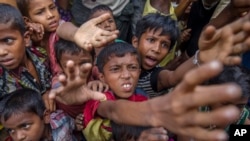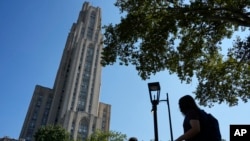Student Union
- By Katie Nicora
Youths Say Leaders Are Failing Them, Global Study Shows

People younger than 30 make up half the world's population, but their well-being has improved by only 2 percent since 2014, says the 2017 Global Youth Wellbeing Index.
"Two percent is pathetic," said Ritu Sharma, director of the Global Center for Gender and Youth at the International Youth Foundation in Baltimore.
At this rate, she said, it would take well over a century to improve the well-being of youths by 100 percent.
"Young people make up half the globe, we cannot take 150 years," she said.
The index ranks 30 countries that are home to approximately 70 percent of youths worldwide. Among people ages 15 to 29 years old who were surveyed, the index found:
- 11 percent experience high levels of well-being.
- The highest levels of well-being are in education; however, too few are getting what they need to be successful in work and life.
- Two in three youths said their government does not care about their wants and needs.
- 74 percent feel they will get the kind of job they want.
- 65 percent feel they will be make as much money as they want.
- Almost 90 percent of youth surveyed agreed that "women should have all the same rights as men."
- Youths rely on phones for information; less than half have access to internet at home.
- Millions of young people, most of them men, used smoking or chewing tobacco products.
- Road-related accidents remain the leading cause of death for youths worldwide.
- Suicide rates are consistently high.
"As the global community works toward achieving the Sustainable Development Goals, too many young people remain disconnected from vital skills, economic opportunities, local communities, and national governments," states the index's executive summary.
It identifies where "investments need to be made now to ensure that this current generation of youth can thrive in a world with increasing challenges."
The Global Youth Wellbeing Index uses 35 indicators to evaluate the state of young people ages 15 to 29 in each participating country. All the indicators fall under seven categories: gender equality, economic opportunity, education, health, safety and security, citizen participation, and information and communication technology.
The 30 participating countries are chosen on population, data availability, income level and regional distribution. All data comes from internationally recognized organizations such as the World Bank, the United Nations, and the World Health Organization.
The index defines well-being as a "multidimensional concept that includes a person's physical and mental health, educational status, economic position, physical safety, access to freedoms, and ability to participate in civic life." Or, more simply, "the abundance or scarcity of opportunities available to an individual."
Global rankings
Sweden ranked first on the index with an overall score of 83. Runners up Australia and the United Kingdom scored 81 and 80, respectively. Germany came in fourth with a score of 78, and the United States was fifth with a 73.
This index is not the first to collect global data solely on youths. The Commonwealth Secretariat's Youth Development Index surveys 183 countries using 18 indicators.
"We also include youth opinion," said Sharma, "Not just hard data."
"I'm not surprised," said Ruby Vishnick, a third-year journalism student at Emerson College in Boston, Massachusetts. This London native credits Britain's welfare state as to why they scored so high.
"People are not scared to go to the doctor, because it's free and it's accessible," she said. "And not only is it easy to book an appointment, you can also walk into any clinic, no questions asked."
Yi Jin Kim, a student from Seoul, also wasn't surprised to hear her country ranked on the index's top 10.
"I personally think the level of education in South Korea is a big factor," she said. Korean students typically go directly to university upon graduating high school.
"This is because our parents' generation really cares about their kids' education, and Korean society is very competitive," she said. "Our parents' generation did not have enough educational opportunities, as Korea at that time was not economically developed at all."
Challenges for youths
More than half the youths who participated in the International Youth Foundation's Global Millennial Viewpoints, which is part of the 2017 Global Youth Wellbeing Index, think emotional challenges get in the way of school, career or life.
"I think what we're seeing now is that the world is way more stressful for young people than it was in the past," Sharma noted. Combined with sparse economic opportunity, feeling unsupported by their government, and inadequate mental health care, that stress can bring drastic results. "In many industrial countries, the suicide rates are consistently high."
Death by road accidents remains high. From 1990 to 2015, index countries reduced youth road-related fatalities by 21 percent. Middle-income countries accounted for 90 percent of traffic-related deaths.
The bottom five countries in the index were Vietnam, India, Uganda, Egypt and Nigeria.
The index is part of the Youth, Prosperity and Security Initiative founded by the Center for Strategic and International Studies and the International Youth Foundation in Washington.
Sharma said CSIS would like to see more indicators added to the index, but since categories must apply to all participating countries and not all countries collect the same data, some indicators will have to wait. With more research and surveys, more countries could participate and the index's analysis could be "even more robust."
How do you feel about the well-being of youths in your country? Please share your suggestion in the Comments here, and visit us on Facebook, Twitter, Instagram and LinkedIn, thanks!
See all News Updates of the Day
- By VOA News
Competition grows for international students eyeing Yale

It’s tough to gain admission to Yale University, and it’s getting even tougher for international students as standout students from around the world set their sights on Yale.
The Yale Dale News, the campus newspaper, takes a look at the situation here.
- By VOA News
Student from Ethiopia says Whitman College culture made it easy to settle in

Ruth Chane, a computer science major from Ethiopia, writes about her experiences settling into student life at Whitman College in the U.S. state of Washington.
"The community at Whitman College made sure I felt welcomed even before I stepped foot on campus," she says.
- By VOA News
Claremont Colleges student gets a shock when she heads home to Shanghai

In The Student Life, the student newspaper for the Claremont Colleges, a consortium of five liberal art colleges and two graduate schools in Claremont, California, student Rochelle Lu writes about readjusting to her Shanghai home after spending a semester in the United States.
- By VOA News
Cedarville University aims to ease transition for international students

Cedarville University in the U.S. state of Ohio says it’s got more than 140 international students representing 44 countries.
Here, the school interviews Jonathan Sutton, director of international student services. He talks about his job and the opportunities for international students on campus.
- By VOA News
Morehouse College offers prospective students tips on applying and thriving

Morehouse College, a private, historically Black liberal arts college in the U.S. state of Georgia, offers a guide for international students interested in attending the school.
Among the tips to apply and thrive at Morehouse:
- Take advantage of the school’s orientation program
- Turn to the school’s Center for Academic Success for tutoring, support and more
- Immerse yourself in campus life via clubs and societies
- By Reuters
US reviews Columbia University contracts, grants over antisemitism allegations

The administration of President Donald Trump said on Monday it will review Columbia University's federal contracts and grants over allegations of antisemitism, which it says the educational institution has shown inaction in tackling.
Rights advocates note rising antisemitism, Islamophobia and anti-Arab bias since U.S. ally Israel's devastating military assault on Gaza began after Palestinian Hamas militants' deadly October 2023 attack.
The Justice Department said a month ago it formed a task force to fight antisemitism. The U.S. Departments of Health and Education and the General Services Administration jointly made the review announcement on Monday.
"The Federal Government's Task Force to Combat Anti-Semitism is considering Stop Work Orders for $51.4 million in contracts between Columbia University and the Federal Government," the joint statement said.
The agencies said no contracting actions had been taken yet.
"The task force will also conduct a comprehensive review of the more than $5 billion in federal grant commitments to Columbia University."
The agencies did not respond to requests for comment on whether there were similar reviews over allegations of Islamophobia and anti-Arab bias.
Columbia had no immediate comment. It previously said it made efforts to tackle antisemitism.
College protests
Trump has signed an executive order to combat antisemitism and pledged to deport non-citizen college students and others who took part in pro-Palestinian protests.
Columbia was at the center of college protests in which demonstrators demanded an end to U.S. support for Israel due to the humanitarian crisis caused by Israel's assault on Gaza. There were allegations of antisemitism and Islamophobia in protests and counter-protests.
During last summer's demonstrations around the country, classes were canceled, some university administrators resigned and student protesters were suspended and arrested.
While the intensity of protests has decreased in recent months, there were some demonstrations last week in New York after the expulsion of two students at Columbia University-affiliated Barnard College and after New York Governor Kathy Hochul ordered the removal of a Palestinian studies job listing at Hunter College.
A third student at Barnard College has since been expelled, this one related to the occupation of the Hamilton Hall building at Columbia last year.
Canada’s immigration overhaul signals global shift in student migration
From Europe to North America, nations are tightening their immigration policies. Now Canada, long seen as one of the world's most welcoming nations, has introduced sweeping changes affecting international students. The reforms highlight a growing global trend toward more restrictive immigration policies. Arzouma Kompaore reports from Calgary.
Trump administration opens antisemitism inquiries at 5 colleges, including Columbia and Berkeley

The Trump administration is opening new investigations into allegations of antisemitism at five U.S. universities including Columbia and the University of California, Berkeley, the Education Department announced Monday.
It's part of President Donald Trump's promise to take a tougher stance against campus antisemitism and deal out harsher penalties than the Biden administration, which settled a flurry of cases with universities in its final weeks. It comes the same day the Justice Department announced a new task force to root out antisemitism on college campuses.
In an order signed last week, Trump called for aggressive action to fight anti-Jewish bias on campuses, including the deportation of foreign students who have participated in pro-Palestinian protests.
Along with Columbia and Berkeley, the department is now investigating the University of Minnesota, Northwestern University and Portland State University. The cases were opened using the department's power to launch its own civil rights reviews, unlike the majority of investigations, which stem from complaints.
Messages seeking comment were left with all five universities.
A statement from the Education Department criticized colleges for tolerating antisemitism after Hamas' Oct. 7, 2023, attack on Israel and a wave of pro-Palestinian protests that followed. It also criticized the Biden administration for negotiating "toothless" resolutions that failed to hold schools accountable.
"Today, the Department is putting universities, colleges, and K-12 schools on notice: this administration will not tolerate continued institutional indifference to the wellbeing of Jewish students on American campuses," said Craig Trainor, the agency's acting assistant secretary for civil rights.
The department didn't provide details about the inquiries or how it decided which schools are being targeted. Presidents of Columbia and Northwestern were among those called to testify on Capitol Hill last year as Republicans sought accountability for allegations of antisemitism. The hearings contributed to the resignation of multiple university presidents, including Columbia's Minouche Shafik.
An October report from House Republicans accused Columbia of failing to punish pro-Palestinian students who took over a campus building, and it called Northwestern's negotiations with student protesters a "stunning capitulation."
House Republicans applauded the new investigations. Representative Tim Walberg, chair of the Education and Workforce Committee, said he was "glad that we finally have an administration who is taking action to protect Jewish students."
Trump's order also calls for a full review of antisemitism complaints filed with the Education Department since Oct. 7, 2023, including pending and resolved cases from the Biden administration. It encourages the Justice Department to take action to enforce civil rights laws.
Last week's order drew backlash from civil rights groups who said it violated First Amendment rights that protect political speech.
The new task force announced Monday includes the Justice and Education departments along with Health and Human Services.
"The Department takes seriously our responsibility to eradicate this hatred wherever it is found," said Leo Terrell, assistant attorney general for civil rights. "The Task Force to Combat Anti-Semitism is the first step in giving life to President Trump's renewed commitment to ending anti-Semitism in our schools."
- By VOA News
STEM, business top subjects for international students

The Times of India breaks down the most popular subjects for international students to study in the U.S.
STEM and business lead the pack. Read the full story here. (January 2025)
- By VOA News
Safety and visa difficulties among misconceptions about US colleges

U.S. News & World report addresses some of the misconceptions about U.S. colleges and universities, including the difficulty of getting a visa.
Read the full story here. (January 2025)
- By VOA News
Work opportunities help draw international students to US schools

US News & World Report details the three top factors in foreign students' decision to study in the U.S. They include research opportunities and the reputation of U.S. degrees. Read the full story here. (December 2024)
- By VOA News
British student talks about her culture shock in Ohio

A British student who did a year abroad at Bowling Green State University in Ohio talks about adjusting to life in America in a TikTok video, Newsweek magazine reports.
Among the biggest surprises? Portion sizes, jaywalking laws and dorm room beds.
Read the full story here. (December 2024)
- By VOA News
Harvard's Chan School tells international students what to expect

Harvard's T.H. Chan School of Public Health reaches out to international students by detailing the international student experience at the school.
Learn more about housing, life in Boston and more here.
- By Reuters
China unveils plan to build 'strong education nation' by 2035

China issued its first national action plan to build a "strong education nation" by 2035, which it said would help coordinate its education development, improve efficiencies in innovation and build a "strong country."
The plan, issued Sunday by the Communist Party's central committee and the State Council, aims to establish a "high quality education system" with accessibility and quality "among the best in the world."
The announcement was made after data on Friday showed China's population fell for a third consecutive year in 2024, with the number of deaths outpacing a slight increase in births, and experts cautioning that the downturn will worsen in the coming years.
High childcare and education costs have been a key factor for many young Chinese opting out of having children, at a time when many face uncertainty over their job prospects amid sluggish economic growth.
"By 2035, an education power will be built," the official Xinhua news agency said, adding that China would explore gradually expanding the scope of free education, increase "high-quality" undergraduate enrolment, expand postgraduate education, and raise the proportion of doctoral students.
The plan aims to promote "healthy growth and all-round development of students," making sure primary and secondary school students have at least two hours of physical activity daily, to effectively control the myopia, or nearsightedness, and obesity rates.
"Popularizing" mental health education and establishing a national student mental health monitoring and early warning system would also be implemented, it said.
It also aims to narrow the gap between urban and rural areas to improve the operating conditions of small-scale rural schools and improve the care system for children with disabilities and those belonging to agricultural migrant populations.
The plan also aims to steadily increase the supply of kindergarten places and the accessibility of preschool education.
- By VOA News
A look at financial aid options for international graduate students in US

The Open Notebook, a site focusing on educating journalists who cover science, has complied a list of U.S. graduate program financial aid information for international students.








